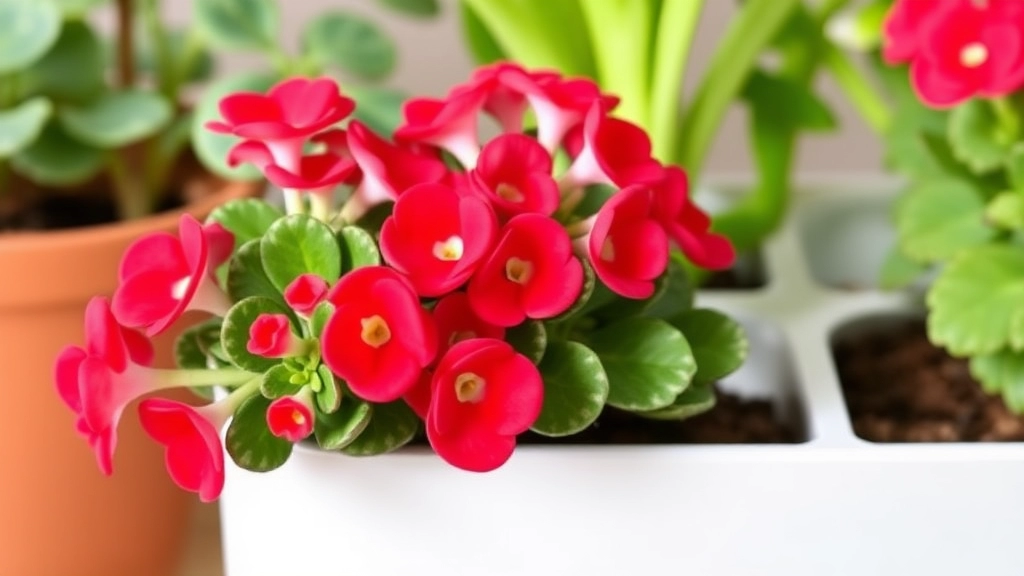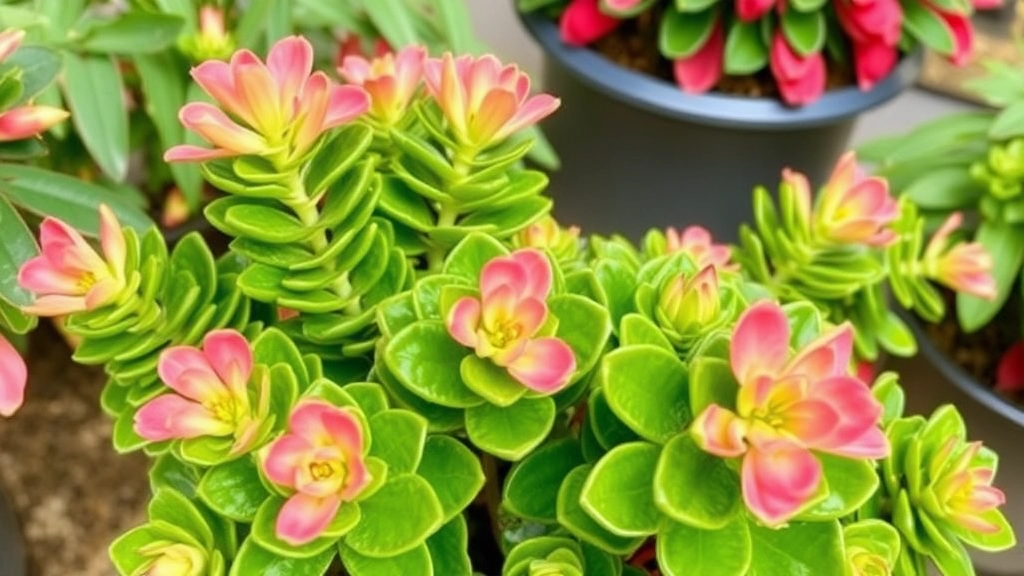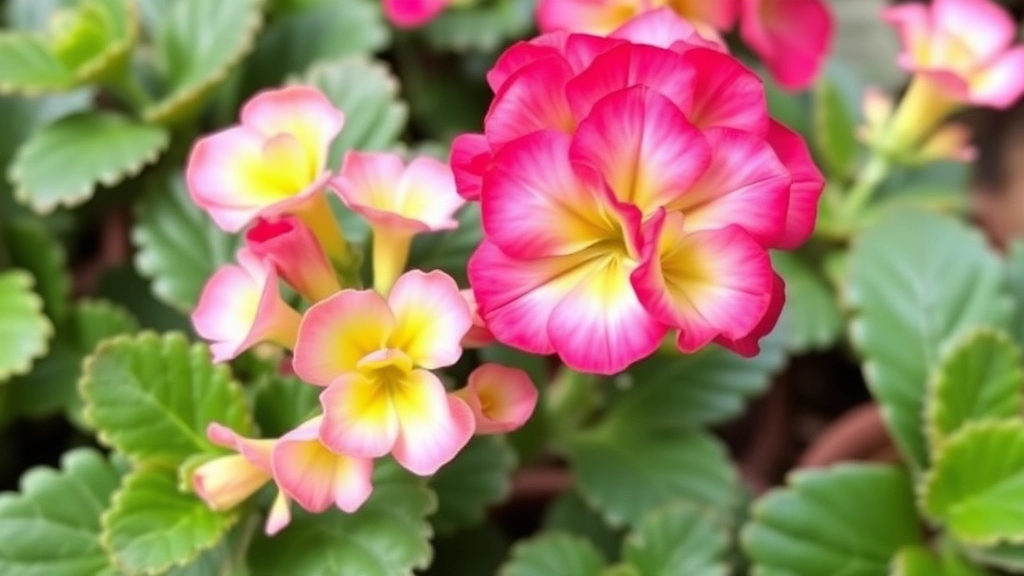Kalanchoe Care Guide
Growth Characteristics
When your Kalanchoe is full grown, it’s a sight to behold with its vibrant blooms and lush foliage. Typically, a mature Kalanchoe reaches about 12-18 inches in height and can spread equally wide. This succulent is a slow grower, taking a few years to achieve its full size, but the wait is well worth it.
Optimal Conditions
To keep your fully grown Kalanchoe thriving, it’s all about providing the right conditions. These plants love bright, indirect sunlight and prefer temperatures between 60-85°F. Watering should be done sparingly; let the soil dry out between waterings to avoid root rot. A balanced, water-soluble fertilizer applied monthly during the growing season will keep your Kalanchoe healthy and blooming.
Typical Size and Growth Rate of a Fully Grown Kalanchoe
When considering the growth of a Kalanchoe, many plant enthusiasts often wonder about its typical size and growth rate.
A fully grown Kalanchoe can reach heights of 30 to 90 cm (12 to 36 inches) and can spread about 30 to 60 cm (12 to 24 inches) wide, depending on the specific variety.
Optimal Conditions for a Fully Grown Kalanchoe

So, you’ve got your fully grown Kalanchoe, and you’re wondering what it needs to thrive, right?
Let’s dive into the optimal conditions that will keep your plant happy and healthy.
Light Requirements
Kalanchoes love light, but not just any light.
- Bright, Indirect Sunlight: Aim for a spot where it can soak up bright, indirect sunlight for about 6 hours a day.
- Avoid Harsh Rays: Direct afternoon sun can scorch those lovely leaves.
Temperature and Humidity
Next up is temperature and humidity.
- Ideal Temperature: Kalanchoes prefer a warm environment, ideally between 18°C to 24°C.
- Humidity Levels: They’re not fussy about humidity, so a standard home environment works just fine.
Soil Type
Now, let’s talk about soil.
- Well-Draining Soil: Use a cactus or succulent mix to ensure proper drainage.
- pH Balance: Aim for a slightly acidic to neutral pH (around 6.0 to 7.0).
Air Circulation
Don’t forget about air circulation!
- Good Ventilation: Make sure your Kalanchoe isn’t crammed in a corner. It needs some fresh air to prevent mold and pests.
Placement
Where you place your Kalanchoe matters too.
- Avoid Cold Drafts: Keep it away from windows that open frequently or air conditioning vents.
Watering and Fertilization Needs of a Full-Grown Kalanchoe
As we delve deeper into the care of a fully grown Kalanchoe, it’s essential to discuss its watering and fertilization needs. Many plant owners often worry about the right balance, fearing overwatering or under-fertilizing might harm their beloved plant.
Watering Needs
Kalanchoes are succulents, which means they store water in their leaves. Here are some key points to consider:
- Frequency: Water your Kalanchoe every 2-3 weeks. Adjust based on humidity and temperature.
- Soil Check: Always check the top inch of the soil. If it feels dry, it’s time to water.
- Watering Technique: Water deeply, allowing excess to drain out. Avoid letting the plant sit in water, as this can lead to root rot.
- Signs of Stress: Yellowing leaves may indicate overwatering, while shrivelled leaves suggest underwatering.
Fertilization Needs
Fertilizing your Kalanchoe can promote healthy growth and vibrant blooms. Here’s how to do it right:
- Type of Fertilizer: Use a balanced, water-soluble fertilizer, preferably one formulated for succulents.
- Frequency: Fertilize every 4-6 weeks during the growing season (spring and summer). Reduce or stop fertilizing in the fall and winter.
- Dilution: Always dilute the fertilizer to half the recommended strength to avoid burning the roots.
- Signs of Nutrient Deficiency: Pale leaves or stunted growth may indicate a need for fertilization.
For more detailed care tips, you might find our expert tips for thriving Kalanchoe plants helpful. Additionally, understanding the best soil for Kalanchoe can significantly improve your plant’s health.
Pruning and Maintenance for a Mature Kalanchoe

As we delve into the care of a fully grown Kalanchoe, you may wonder how to keep this vibrant plant healthy and thriving. Pruning and maintenance are essential aspects of Kalanchoe care that not only enhance its appearance but also promote new growth.
Why Prune Your Kalanchoe?
Pruning serves multiple purposes:
- Encourages New Growth: Removing dead or wilted leaves can stimulate fresh growth.
- Maintains Shape: Regular trimming helps maintain a compact and attractive shape.
- Prevents Disease: Eliminating unhealthy foliage reduces the risk of pests and diseases.
When to Prune
The best time to prune your Kalanchoe is during its active growing season, typically in spring or early summer. This timing allows the plant to recover quickly and flourish.
How to Prune
Here are some straightforward steps for effective pruning:
- Gather Tools: Use clean, sharp scissors or pruning shears.
- Inspect the Plant: Look for dead, yellowing, or damaged leaves.
- Cut Carefully: Trim the affected leaves at their base, ensuring not to damage the healthy parts of the plant.
- Shape the Plant: For aesthetic purposes, lightly trim the edges of the plant to maintain its desired shape.
Maintenance Tips
In addition to pruning, regular maintenance will keep your Kalanchoe in top condition:
- Dust Leaves: Wipe the leaves with a damp cloth to remove dust, allowing the plant to breathe better.
- Check for Pests: Regularly inspect for common pests like mealybugs or aphids. If you spot any, treat them promptly with insecticidal soap.
- Rotate the Plant: Occasionally rotating your Kalanchoe ensures even light exposure, promoting balanced growth.
By following these pruning and maintenance tips, you can ensure your fully grown Kalanchoe remains a stunning addition to your indoor garden.
Have you noticed your Kalanchoe becoming root-bound or outgrowing its pot?
Repotting is essential for maintaining a healthy, vibrant plant.
### When to Repot
Timing is crucial.
The best time to repot your fully grown Kalanchoe is during the spring, just as it begins its active growth phase.
### Signs That Your Kalanchoe Needs Repotting
Look for these indicators:
– **Roots Emerging from Drainage Holes:** If you see roots poking out, it’s time for a bigger pot.
– **Stunted Growth:** If your plant isn’t growing as it should, it might be out of nutrients or space.
– **Soil Drying Out Quickly:** If the soil dries out faster than usual, it may not be able to retain moisture properly.
### Choosing the Right Pot
Selecting the right pot is key:
– **Size:** Choose a pot that is 1-2 inches larger in diameter than the current one.
– **Material:** Terracotta pots are great for Kalanchoes, as they allow for better airflow and drainage.
– **Drainage Holes:** Ensure the pot has adequate drainage to prevent root rot.
### Steps to Repot Your Kalanchoe
1. **Prepare Your Materials:** Gather fresh potting mix, a new pot, and any tools you might need.
2. **Remove the Plant:** Gently take the Kalanchoe out of its current pot, being careful not to damage the roots.
3. **Inspect the Roots:** Trim any dead or overly long roots with sterile scissors.
4. **Add Soil:** Place a layer of fresh potting mix at the bottom of the new pot.
5. **Position the Plant:** Set the Kalanchoe in the centre and fill around it with more potting mix, ensuring it’s stable.
6. **Water Thoroughly:** After repotting, give it a good drink to help settle the soil.
### Post-Repotting Care
After repotting, keep an eye on your Kalanchoe:
– **Light:** Place it in a spot with bright, indirect light.
– **Watering:** Allow the soil to dry out between waterings for a week or so before resuming your normal schedule.
For more detailed care tips, you can explore our [complete guide to caring for Kalanchoe succulents](https://planthq.org/caring-for-your-kalanchoe-succulent-a-complete-guide/) or learn about [post-flowering care tips for Kalanchoe](https://planthq.org/postflowering-care-tips-for-kalanchoe/).
Common Issues with Fully Grown Kalanchoe and How to Address Them
So, you’ve nurtured your Kalanchoe to maturity, but now you’re facing some hiccups.
What’s going wrong?
Let’s dive into some common issues and how to tackle them head-on.
1. Leaf Dropping
What’s Happening?
If your Kalanchoe’s leaves are dropping, it might be a sign of stress. This can happen due to overwatering or sudden temperature changes.
How to Fix It:
- Check the Soil: Make sure it’s not soggy. If it is, let it dry out before watering again.
- Temperature Control: Keep your plant in a stable environment, away from drafts.
2. Leggy Growth
What’s Happening?
If your Kalanchoe looks more like a stretch Armstrong than a bushy beauty, it’s likely not getting enough light.
How to Fix It:
- Move It to a Brighter Spot: Kalanchoes love bright, indirect sunlight. A south-facing window is ideal.
- Rotate the Plant: This helps it grow evenly without leaning towards the light.
3. Pests
What’s Happening?
Tiny critters like aphids or mealybugs can invade your plant, causing damage.
How to Fix It:
- Inspect Regularly: Keep an eye out for any unwelcome guests.
- Use Insecticidal Soap: A gentle spray can help eliminate pests without harming your plant.
4. Discolored Leaves
What’s Happening?
Yellow or brown leaves can indicate nutrient deficiencies or overwatering.
How to Fix It:
- Adjust Watering: Ensure you’re not watering too frequently. Let the soil dry out between waterings.
- Fertilize Sparingly: Use a balanced fertilizer during the growing season but avoid overdoing it.
5. Flowering Issues
What’s Happening?
If your Kalanchoe isn’t blooming, it might not be getting enough light or might need a rest period.
How to Fix It:
- Provide Adequate Light: Ensure it gets enough indirect sunlight.
- Give It a Break: After flowering, allow your plant to rest for a few weeks.
For more detailed care tips, check out our Ultimate Guide to Flowering Kalanchoe Care Tips and learn how to Deadhead Kalanchoe Flowers for Continuous Blooming.
FAQs on Fully Grown Kalanchoe Care
What kind of light does a fully grown Kalanchoe need?
A fully grown Kalanchoe thrives in bright, indirect sunlight for about 6 hours a day. Avoid placing it in direct afternoon sun as it can scorch the leaves.
What is the ideal temperature for a mature Kalanchoe?
Kalanchoes prefer a warm environment, ideally between 18°C to 24°C. They are not particularly fussy about humidity, making them suitable for standard home environments.
What type of soil should I use for my Kalanchoe?
Use a well-draining soil such as a cactus or succulent mix. Aim for a slightly acidic to neutral pH, around 6.0 to 7.0.
How important is air circulation for a Kalanchoe?
Good air circulation is crucial to prevent mold and pests. Make sure your Kalanchoe is not crammed in a corner and has access to fresh air.
Where should I place my Kalanchoe in the house?
Avoid placing your Kalanchoe near windows that open frequently or air conditioning vents, as cold drafts can harm the plant.
Why is pruning important for a fully grown Kalanchoe?
Pruning encourages new growth, maintains the plant’s shape, and helps prevent disease by removing unhealthy foliage.
When is the best time to prune my Kalanchoe?
The optimal time to prune your Kalanchoe is during its active growing season, typically in spring or early summer.
How should I prune my Kalanchoe?
Use clean, sharp scissors or pruning shears to trim dead, yellowing, or damaged leaves at their base. Lightly trim the edges to maintain the plant’s desired shape.
What are some maintenance tips for a fully grown Kalanchoe?
Regularly dust the leaves with a damp cloth, check for pests like mealybugs or aphids, and rotate the plant occasionally to ensure even light exposure.
References
-
The Spruce: Growing Kalanchoe Succulents
-
Gardening Know How: Kalanchoe Care
-
Old Farmer’s Almanac: How to Grow Kalanchoe
